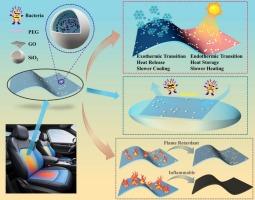基于交联改性相变微胶囊的高效热管理聚氨酯泡沫涂料的制备:集温度调节、阻燃和抗菌功能于一体
IF 8.9
2区 工程技术
Q1 ENERGY & FUELS
引用次数: 0
摘要
聚氨酯(PU)泡沫以其轻量化、缓冲、减震和隔音性能而闻名,是汽车轻量化和安全设计的理想材料。然而,传统的PU泡沫耐热性较差,缺乏主动热管理、阻燃、抗菌等性能,限制了其在新能源汽车等高性能领域的应用。结合相变材料(PCM)是实现主动温度调节的有效策略,但开发一种既耐热又耐损伤,同时提供阻燃和抗菌功能的PCM仍然是一个重大挑战。为了解决这一问题,通过将多层氧化石墨烯(GO)交联框架与聚乙二醇(PEG)集成,构建了半互穿聚合物网络(semi-IPN)。随后,本研究以二氧化硅(SiO2)为包封壳制备了核壳结构的GO/PEG@SiO2相变微胶囊。这些相变微胶囊随后通过涂层和高温发泡技术集成到水性PU泡沫中,从而形成微胶囊改性泡沫涂层。实验结果表明,与传统PU涂层相比,微胶囊改性泡沫涂层具有更好的温度调节性,最大温差为32.9℃。此外,复合涂层在引入主动热调节的同时保留了被动保温性能,并实现了协同阻燃(V-2级)和抗菌功能。本研究为设计高性能、多功能的汽车内饰材料提供了新的思路。本文章由计算机程序翻译,如有差异,请以英文原文为准。

Preparation of highly efficient thermal management polyurethane foam coatings based on crosslinked modified phase change microcapsules: Integration of temperature regulation, flame retardancy, and antibacterial functions
Polyurethane (PU) foam, known for its lightweight nature, cushioning, shock absorption, and sound insulation properties, is an ideal material for automotive lightweighting and safety design. However, conventional PU foam has poor heat resistance and lacks active thermal management, flame retardancy, and antibacterial properties, which limits its application in high-performance areas such as new energy vehicles. Incorporating phase change materials (PCM) is an effective strategy for achieving active temperature regulation, but developing a PCM that is both heat-resistant and damage-resistant while simultaneously providing flame retardancy and antibacterial functions remains a significant challenge. To address this issue, a semi-interpenetrating polymer network (semi-IPN) was constructed through the integration of a multilayer graphene oxide (GO) crosslinked framework with polyethylene glycol (PEG). Subsequently, silica (SiO2) was employed as an encapsulating shell to fabricate core-shell structured GO/PEG@SiO2 phase change microcapsules in this study. These phase change microcapsules were subsequently integrated into water-based PU foam via coating and high-temperature foaming techniques, resulting in a microcapsule-modified foam coating. Experimental results indicate that, compared to conventional PU coating, the microcapsule-modified foam coating exhibits superior temperature regulation, with a maximum temperature difference of 32.9 °C. Moreover, the composite coating retains passive insulation properties while introducing active thermal regulation, and achieves synergistic flame retardancy (V-2 rating) and antibacterial functionality. This study offers a new strategy for designing high-performance, multifunctional automotive interior materials.
求助全文
通过发布文献求助,成功后即可免费获取论文全文。
去求助
来源期刊

Journal of energy storage
Energy-Renewable Energy, Sustainability and the Environment
CiteScore
11.80
自引率
24.50%
发文量
2262
审稿时长
69 days
期刊介绍:
Journal of energy storage focusses on all aspects of energy storage, in particular systems integration, electric grid integration, modelling and analysis, novel energy storage technologies, sizing and management strategies, business models for operation of storage systems and energy storage developments worldwide.
 求助内容:
求助内容: 应助结果提醒方式:
应助结果提醒方式:


